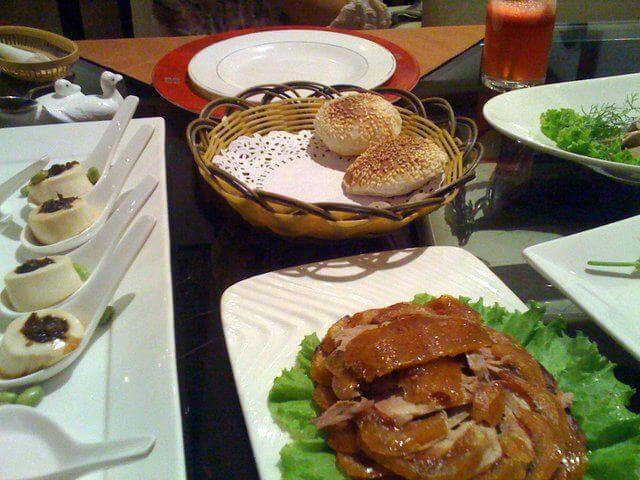
The only restaurant I’d heard of in Beijing before my arrival was DaDong, a strong contender for the maker of the best Roast Peking Duck in Beijing. The first time I was in Beijing a few years ago I eagerly visited a restaurant called simply ‘Peking Duck’ and was presented with a plate of soggy duck fat and a fork. DaDong is renowned for creating a mix of crispy skin and succulent, juicy flesh on the same bird – no mean feat as the temperatures required to make skin crispy can easily dry the body of the duck.
The reason I’d heard of the restaurant before was through visits by Heston Blumenthal and Anthony Bourdain, where the head chef, a Mr Da Dong, explained the process. The duck is expanded using compressed air to separate the skin from the flesh, and then partially frozen to dehydrate it a little which aids the crispiness. In his quest for perfection, Da Dong has developed a special round oven to ensure the heat from the wood fires is evenly distributed.
Here’s the clip from HB – He eats at Quanjude then learns the process from Da Dong:
Browsing through the beautiful 160 page menu it’s clear that DaDong isn’t just limited to duck, but the rest of the dishes are nouvelle cuisine small and hugely expensive (for China) in comparison to the star attraction. I was very tempted by Beef with Green Lemon but £38 for 6 cubes of meat wasn’t going to happen, and some of the more exotic dishes such as Shark’s Fin ran to over £130.
First to arrive was the ducks liver. Thinly sliced, the liver was the perfect blend of richness and lightness, just melting in the mouth. Next up was the vegetable – it was on the menu as bean sprout, but unlike the white fibrous UK namesake this is actually Snow Pea tips and shoots. Unlike anything I’ve seen at home these are available in almost any restaurant here for next to nothing. Simple and quick to prepare they are rapidly becoming my favourite vegetable.
Snow pea tips recipe: http://xuewang.blogspot.com/2007/12/stir-fried-snow-pea-tips.html
A short while later our ‘Bean curd cooked two ways’ arrived. Ten soft roundels of tofu had been individually placed on spoons and served with two styles of topping – a seafood concoction which was decent, but not to my taste, and some preserved vegetables which were again well made, but just not that exciting to eat.
Finally the duck arrived, and we had to sit and look at it for 10 minutes more whilst a chef expertly skinned and sliced it beside the table. I’m not sure if it was intentional or due to the strong air conditioning, but I immediately noticed a complete lack of smell coming from the duck. At home the waitress will also bring the duck to the tableside, and then roughly but expertly shred it with a pair of forks. This releases the unique and mouth-watering aromas, causing anticipation and impatience round the table and jealousy throughout the restaurant, until the mound of shredded meat has been hungrily devoured.
At DaDong we were instead given a surgically prepared dome of meat, topped with the shiny bronze crispy skin, giving it the unintentional appearance of a small turtle. At the same time we were given a steamer of wonderfully light, yet surprisingly strong pancakes and two shaobing which are hollow sesame buns.
Each person also gets a selection of 8 types of dip – julienned leek, radish and cucumber, pureed garlic, sugar, bittersweet sauce (a less sweet version of the hoisin sauce we get at home), and two ground up preserved vegetables. Annoyingly this incurs an 8RMB charge for what most people would consider an integral part of the duck experience.
Anyway, time for duck. DaDong creates a “superlean” duck, with only about a third of the fat of a usual Peking duck – this manifests itself as a sweet brittle skin attached to a layer of aerated fat with a light honeycomb texture. The wait staff suggest that it be eaten simply dipped in the sugar for the best flavour and they were right – the skin just melts in the mouth and the sugar offsets the little of what remains of the greasiness.
After the skin is the duck flesh. This is best eaten with the supplied pancakes, wrapped up with any combination of the seven remaining dips. Alternatively you can fill the shaobing to make a tricky-to-eat sesame topped duck burger.
As the meat pile receded we were presented with the two best parts of the duck – a slither of meat from the centre of the duck, and the pinnacle of duck flavour: the head with brain still intact. I selflessly gave away the best part of the duck and was left with the boring old perfect duck fillet. Ha!
At this point the wait staff got bored and cleared away the table before we’d finished eating – pouring all the food onto one plate and giving us a complimentary lychee sorbet and smoking fruit bowl to hurry us along.
Overall the food was outstanding, but the meal wasn’t actually enjoyable. The tables were too big to have a decent conversation over the background noise of the restaurant; the staff were not very attentive and the general ambience of the place was just not relaxing. Since being featured by Anthony Bourdain and in the Lonely Planet and Frommer’s it’s possible it’s become a victim of its own success – there are just too many people there, too few of whom have any manners. From American businessmen getting in everyone’s way so they can make a 10 minute video of the cutting up of a duck, to Japanese taking dozens of overpowered flash photos, and rural Chinese just standing next to the table and watching us eat.
Note: Peking is the old Romanised name for Beijing, given by French missionaries 400 years ago, and only reverted at the end of World War II, when the Japanese called it by the Mandarin name, which has been adopted by the rest of the world. Aside from duck, the only other two Beijing institutions to retain the name are Peking Opera and Peking University.
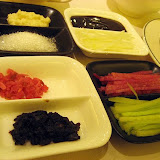

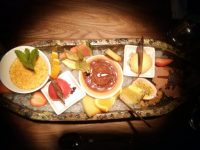
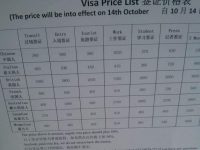
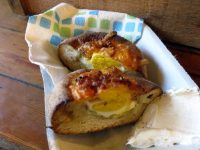





DaDong Peking Duck is really delicious, I’ve tasted it once when i visited Shenzhen last month.
Pingback: Ming Foods Ltd (@mingfoods)
Pingback: How not to be a food blogger | You're Not From Around Here, Are You?